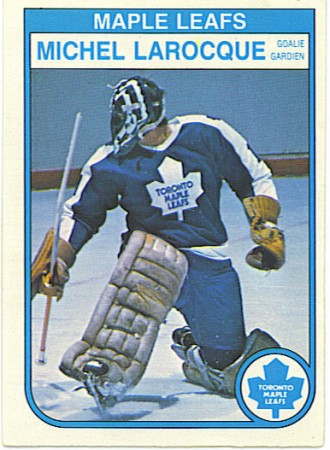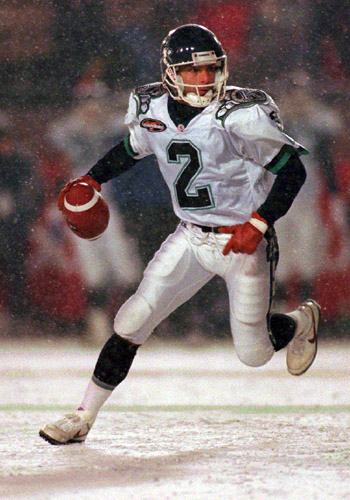A number of years ago I was at a conference listening to a presentation on data warehousing. The presenter was a Habs fan from Toronto (though in all other respects, his presentaton was very good).
At one point, he addressed the audience (which was about 95% American) and asked, "Do any of you know who Bunny Larocque was?"
I was the only person to put up a hand.
"Yes," I said, "He was quite possibly the single worst starting goaltender in the history of the Toronto Maple Leafs."
The guy was taken aback.
"Well, that's probably true. But he was also the greatest backup you could ask for when he played in Montreal."
"He had a cool mask, though," I offered.
Anyway, he went on with his presentation and nobody paid any mind to this oddball aside by two Canadians.
I have to dispute his assertion, though. I'm not convinced he was a great backup, either.
Part of it, I suppose, comes down to how one defines "great backup." I imagine he didn't complain about a lot, and that helps. I mean, all he had to do was face the Seals, Scouts and Capitals of the world, keep his mouth shut and walk away with yet another Cup ring when the season was over. Not a bad life, really.
But it has always struck me that despite playing behind the same Big Three that Dryden did, and playing all those lousy teams, his GAA was always a good half goal higher than Dryden's was. The win/loss record is kind of deceiving this way. Yes, the Habs beat the Seals 8-3, or whatever, but Dryden would have shut them out.
This all became apparent when he became the Leaf starter and his average suddenly jumped into the high fours/low fives. Benning, Boimistruck and McGill wasn't really the equivalent of Robinson, Lapointe and Savard and now, instead of facing Washington, he was drawing Montreal and Edmonton. It wasn't his fault, really. He was just completely and utterly miscast in Toronto and it showed.
I'll just let that stand.
Now, Bunny isn't really what I wanted to talk about today, but there isn't really a Leaf who illustrates it quite the way I want. The person I really want to talk about is this guy:
via images.theglobeandmail.com
This, to me, is the classic Doug Flutie picture - on the run, looking for something nobody sees, ready to let fly. Doug was the master of the broken play. He was at his most dangerous when things were mostly falling apart, someone was on him and he had to find something while on the run. If the basic plan of the Argos' offensive line wasn't to simply cause havoc and let Doug find something, it should have been. He was awesome at it.
I was working in Buffalo the year he joined the Bills. His first game, he won it late and everyone was gushing over his return. You look at the stat line, though, and he'd gone something like 99 yards in the air. Here, we'd have said it was a lousy game, but he'd scratched something out.
The Bills had this other guy they kept dreaming would be an NFL quarterback. I think his name was Rob Johnson. He was the standard-issue 6'4" monster with the big arm. He just wasn't all that good. The Bills kept oscillating between the two of them, wanting Johnson and going back to Flutie every time Johnson was losing. Flutie would win another one, or have them close, then Johnson would come in and lose it. You'd think they'd learn.
For all that the fans liked him though (remember Flutie Flakes?), Flutie never established himself quite the way I'd have expected. A buddy of mine down there was a big Bills fan and his assessment was this: the Bills wanted a guy who was 6'4" who could stand in the pocket and sling it. They had no idea how to coach a guy like Flutie. The only thing they knew to tell him was to pretend he was Johnson. They couldn't maximize the talents of the guy they had - they needed instead to fit him into the way they coached. For all that this was supposed to be the best football league in the world, the coaches came off to me like a bunch of morons.
Now, and I know we're not to say a certain name today, but ask yourself this: name me a successful 5'9" butterfly goaltender. I honestly can't think of one.
The butterfly seems to me to be a tall goalie's game. If you're going to be dropping to your knees a whole lot, it would help if this didn't mean completely abandoning the upper half of the net. A smaller goaltender has to play a different game - be more aggressive and out at the top of the crease, play the angles, take away the shot.
We've hired what is supposed to be the ultimate goaltending guru, but is it serving both of them well if what he teaches is at odds with what one of the goalies needs to do to be successful? As they say in basketball, you can't teach tall.
Just stuff I'm wondering about based on a couple of throwaway lines in some Leaf articles - both MSM and other.
Bunny did have a cool mask.
Bunny's stats:
| 1967-68 | Ottawa 67's | OHA-Jr. | 4 | 0 | 9.14 | |||||||||
| 1968-69 | Ottawa 67's | OHA-Jr. | 4 | 0 | 7.58 | |||||||||
| 1969-70 | Ottawa 67's | OHA-Jr. | 51 | 3 | 3.63 | 11 | 4 | 6 | 1 | 3 | 3.46 | |||
| 1970-71 | Ottawa 67's | OHA-Jr. | 56 | 5 | 3.39 | |||||||||
| 1971-72 | Ottawa 67's | OHA-Jr. | 55 | 4 | 3.45 | 18 | 8 | 7 | 3 | 1 | 3.21 | |||
| 1972-73 | Nova Scotia Voyageurs | AHL | 47 | 1 | 2.50 | 13 | 0 | 2.84 | ||||||
| 1973-74 | Montreal Canadiens | NHL | 27 | 15 | 8 | 2 | 0 | 2.89 | 6 | 2 | 4 | 0 | 2.97 | |
| 1974-75 | Montreal Canadiens | NHL | 25 | 17 | 5 | 3 | 3 | 3.00 | ||||||
| 1975-76 | Montreal Canadiens | NHL | 22 | 16 | 1 | 3 | 2 | 2.46 | ||||||
| 1976-77 | Montreal Canadiens | NHL | 26 | 19 | 2 | 4 | 4 | 2.09 | ||||||
| 1977-78 | Montreal Canadiens | NHL | 30 | 22 | 3 | 4 | 1 | 2.67 | ||||||
| 1978-79 | Montreal Canadiens | NHL | 34 | 22 | 7 | 4 | 3 | 2.84 | 1 | 0 | 0 | 0 | 0.00 | |
| 1979-80 | Montreal Canadiens | NHL | 39 | 17 | 13 | 8 | 3 | 3.32 | 5 | 4 | 1 | 1 | 2.20 | |
| 1980-81 | Montreal Canadiens | NHL | 28 | 16 | 9 | 3 | 1 | 3.03 | ||||||
| 1980-81 | Toronto Maple Leafs | NHL | 8 | 3 | 3 | 2 | 0 | 5.22 | 2 | 0 | 1 | 0 | 6.40 | |
| 1981-82 | Toronto Maple Leafs | NHL | 50 | 10 | 24 | 8 | 0 | 4.69 | ||||||
| 1982-83 | Toronto Maple Leafs | NHL | 16 | 3 | 8 | 3 | 0 | 4.89 | ||||||
| 1982-83 | Philadelphia Flyers | NHL | 2 | 0 | 1 | 1 | 0 | 4.00 | ||||||
| 1983-84 | Springfield Indians | AHL | 5 | 3 | 2 | 0 | 0 | 4.18 | ||||||
| 1983-84 | St. Louis Blues | NHL | 5 | 0 | 5 | 0 | 0 | 6.20 | ||||||
| 1984-85 | Peoria Rivermen | IHL | 13 | 7 | 3 | 3 | 0 | 3.13 | ||||||
| Leaf Totals | 74 | 16 | 35 | 13 | 0 | 4.79 | 2 | 0 | 1 | 0 | 6.40 | |||
| NHL Totals | 312 | 160 | 89 | 45 | 17 | 3.33 | 14 | 6 | 6 | 1 | 2.92 |
the HHOF take on Bunny:
"Netminder Michel Larocque spent eleven years in the NHL. He was best known as Ken Dryden's backup when the Montreal Canadiens dominated the league in the 1970s.Born in Hull, Quebec, Larocque crossed the Ottawa River to play junior in the OHA with the 67's. Beginning in 1969-70, he led the league in shutouts three straight years and played 162 games over that same time. He also posted the lowest goals against mark in the OHA twice and was named to the league's first and second all-star teams once each. Larocque was also picked as an honourary junior with Team Canada for the 1972 Summit Series against the USSR.
The young star was selected sixth overall by the Montreal Canadiens at the 1972 Amateur Draft. He made an impressive pro debut the next year with a league leading 2.50 goals against average in 47 games for the AHL's Nova Scotia Voyageurs. Larocque was voted on to the league's second all-star team and appeared ready for the NHL.
When Ken Dryden sat out the 1973-74 season to finish law school, Larocque played 27 games as a rookie backing up Wayne Thomas and Michel Plasse. His confidence was give a boost when Montreal opted to start him in the post-season but the team was knocked out by the New York Rangers in first round.
Following the return of Dryden in 1974-75, Larocque settled in as the Habs' backup for the next five seasons. He averaged 30 appearances per year and was a part of the club's four consecutive Stanley Cup wins between 1976 and 1979. Beginning in 1977, he shared the Vezina trophy for three straight years with Dryden.
In 1979-80, Montreal was forced to retool and brought Denis Heron in to share the goalkeeping responsibilities with Larocque. The club was eliminated in the quarter-finals by the Minnesota North Stars and the veteran netminder was relegated to second string status in 1980-81. Prior to the March deadline he was sent to the Toronto Maple Leafs for Robert Picard. He saw plenty of rubber behind the Leafs' horrid defence and was in goal when the Buffalo Sabres scored an NHL-record nine goals in one period during a 14-4 loss. Larocque helped Toronto squeeze into the playoffs where they were crushed by the New York Islanders.
Larocque attempted to start fresh in 1981-82 and played 50 games for a Toronto team that managed to be worse than the previous year's edition. He toiled briefly for the Leafs in 1982-83 before moving on to Philadelphia and St. Louis. He retired after playing 13 games for the IHL's Peoria Rivermen in 1984-85."




